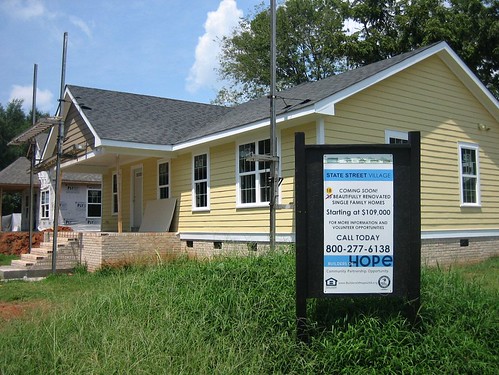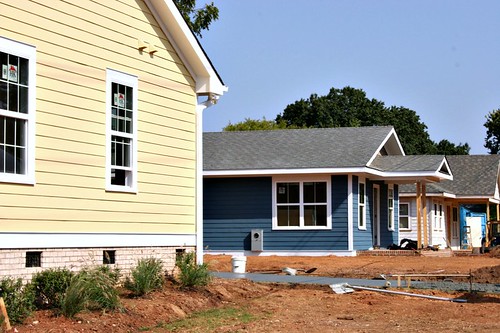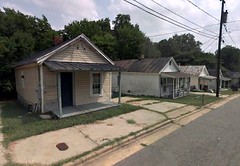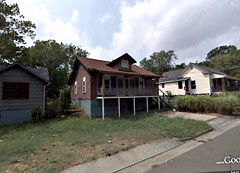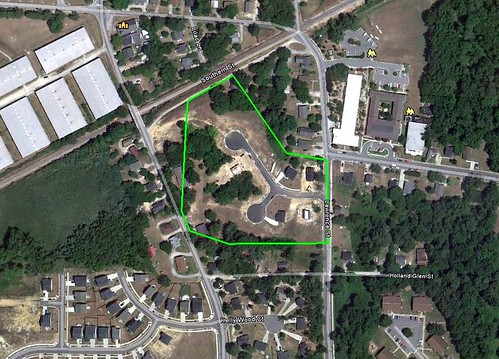Builders of Hope creates community through innovative approach to preservation, sustainability, jobs and affordable housing

Posted November 16, 2010 at 1:33PM

The headline pretty much sums it up. What’s not to like? Builders of Hope is a remarkable North Carolina-based charity that saves older houses from demolition (frequently moving them to a new site), thoroughly rehabbing them to green standards. They then put the homes up for sale at below-market rates to qualifying buyers. (In addition, some of the organization's homes are sold at market rates.) Even better, although the organization benefits from a lot of volunteer help, they also make a concerted effort to hire homeless and other people in transitional situations for their moving and construction work.
If you’ve read this blog before, you know I’m not a big fan of demolitions. Working with, rather than tearing down, older buildings helps save the historic fabric of a community while also taking advantage of the energy and resources embedded in the original construction. While Builders of Hope frequently is unable to save the original neighborhood context of the buildings they restore – their sites are slated for new construction - they are at least able to recycle the buildings and put them to an immensely worthy use, creating new neighborhood fabric with some of the original character. And, in some cases, they are able to save, rehab and green the houses on their original sites.
Builders has gotten a ton of publicity, and justly so. Wanda Urbanska wrote earlier this year in Natural Home:
“Americans demolish some 250,000 homes annually, according to the Environmental Protection Agency, and many of them are more solidly built than the new structures that replace them. Though in recent years developers have increased efforts to salvage reusable items such as bathtubs, light fixtures and mantels, mountains of demolition debris still clog our nation’s landfills.
“Nancy Murray, a former advertising executive in Raleigh, North Carolina, saw gold where others saw garbage. Why not, she wondered, turn our inventory of sturdy but out-of-style housing stock into affordable housing? In late 2006, Murray founded Builders of Hope, a nonprofit organization that saves tear-down homes from the wrecking ball, rehabilitates them with health- and environmentally conscious materials, and either moves the rescued houses into new clustered communities or leaves them as anchors to help revitalize existing neighborhoods.”
The organization has built or preserved several neighborhoods in North Carolina and has also recently begun a rescue effort to save homes in the construction path of the highly controversial new Veterans’ Administration hospital in New Orleans. It’s hard to feel joyful about the potential displacement of historic neighborhoods for a facility that the National Trust calls “suburban-style,” but one can indeed take comfort that not all the homes in harm’s way will be lost. Jennifer Farwell writes about the New Orleans project for Preservation’s online site:
“In the first week of September, a Raleigh-based nonprofit called Builders of Hope and its contractors conducted several test moves of historic houses. The following week, the team began moving between eight and ten houses per week, and as of October 1, had moved nearly 30 structures.
“So far, some of the properties have been relocated within their Mid-City National Register District. Others have been moved to the neighboring Parkview Historic District. Where the structures end up depends on lot availability, and there has been talk of taking some houses as far as the Lower Ninth Ward. In all cases, preservationists hope the houses can act as much-needed historic infill in neighborhoods where post-Katrina demolitions have left hundreds of vacant lots. The project is saving houses that would otherwise have been destroyed for the new hospital.”
Go here for the full story. (See also this article in The Next American City.)
You can get some of the flavor of the work of Builders of Hope in the images accompanying this post. I am especially supportive of the New Orleans activity and some in-town projects including, for example, Raleigh’s State Street Village and Durham’s Rock Street, whose badly deteriorated pre-rehab houses are shown in the images taken from Google Earth’s Street View, just above.
The organization's projects might be even better, though, with a more progressive approach to neighborhood pattern and design. Builders’ projects and advertising so far exhibit a decided preference toward disconnected cul-de-sacs, even in the city. (See below for one example.) Where there has been an opportunity to improve a neighborhood by connecting streets, the site planners have chosen not to do so in favor of a suburban model, even eschewing sidewalks in some cases. Indeed, one of the organization’s better-known (and quite attractive) projects, Raleigh's Barrington Village, has an especially unwalkable, hyper-suburban setting, described in the Wall Street Journal as "in an isolated pocket, unconnected to other neighborhoods and lacking stores." (I should note that the rest of the article was highly complimentary, for all the right reasons.)
Given that the Raleigh-Durham area, which this North Carolina native visits often, is one of the most automobile-dependent, sprawling places on the planet, I suppose I shouldn’t be surprised that new dead-end streets and continued car dependence are taken for granted. But I can't help but think that this organization's fantastic work could realize even greater transformative potential by collaboration with good urbanist neighborhood planners such as Dover, Kohl (which has done quite a bit of work in North Carolina) or Goody, Clancy (which has done planning in Asheville and New Orleans). I'm sure that budget is an important consideration but I don't think that some basic conceptual advice and tweaks to the design and construction need add much cost.
That reservation aside, there is so much to love about this work. Wendy Koch profiled the organization in USA Today:
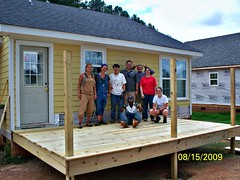
“Murray, a high-energy mother of four, talks fast as she drives around Raleigh, explaining how her group has created two eco-friendly enclaves in what were once blighted areas of town.
"’You can create a neighborhood just like that,’ she says, snapping her fingers. She says moving a house doesn't take long, and once it's placed on a new foundation, her workers can rebuild it within three months for $89 a square foot.
“Her group, which now employs 50 people — some of them ex-offenders learning construction — also rehabs homes onsite. It often strips them to the studs, adding lots of insulation, high-performance windows as well as efficient appliances, lighting and HVAC heating/cooling equipment. Monthly utility bills average less than $50.
“Builders of Hope has already rebuilt 62 single-family homes and 63 apartments in four North Carolina towns and has acquired lots for dozens of other houses, Murray says. It has received about $8 million in federal funds for land acquisition and gets bank loans as well as private donations for the construction.
“Murray expects her group will have diverted 11 million pounds of debris from landfills by the end of this year.”
Good stuff. I leave you with this neat video of the organization’s work, which really personalizes the story:
Move your cursor over the images for credit information. Many thanks to Merry Rabb for putting me onto this story.
